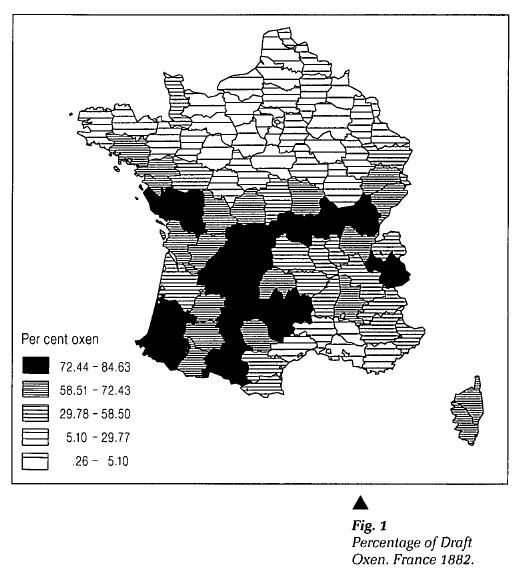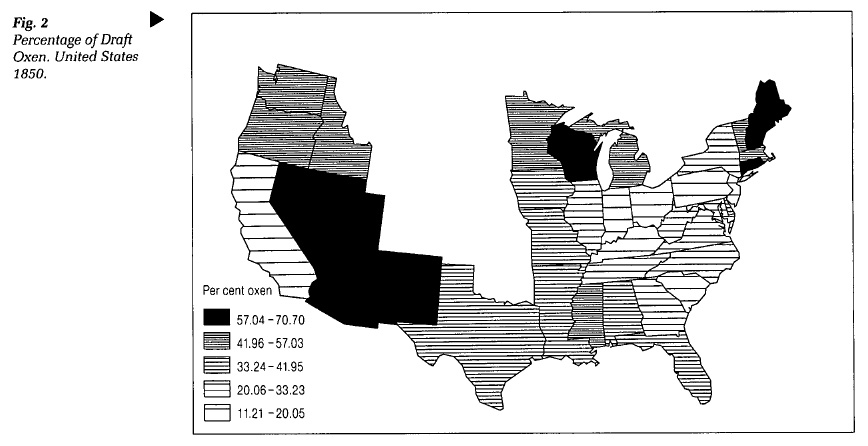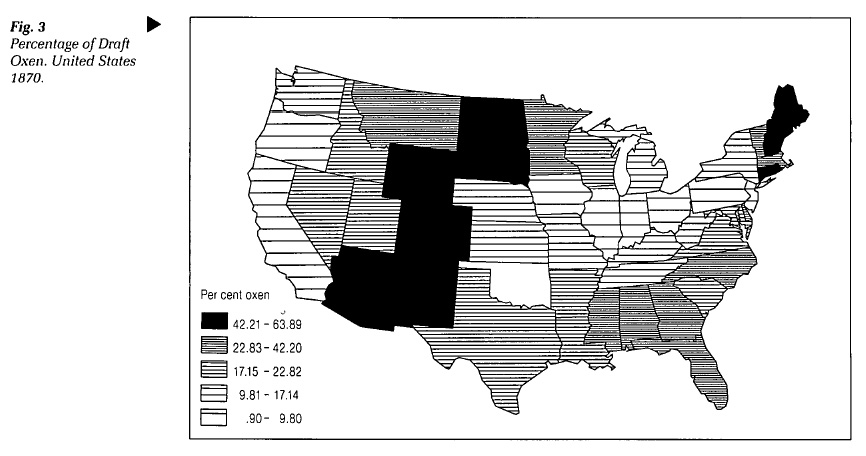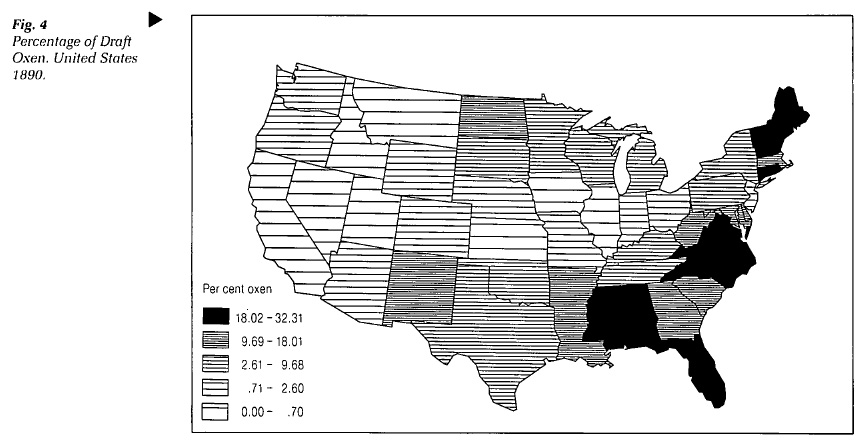Articles
The Persistence of Draft Oxen in Western Agriculture
Abstract
Draft oxen were not displaced by horses from western agriculture in the Middle Ages, but continued to play an important role until the late nineteenth century and even into the twentieth. Oxen persisted in many isolated regions of France and the United States, and were also found wherever they could fit in with specialized types of farming.
Résumé
Les bœufs de trait n'ont pas été complètement remplacés par des chevaux dans l'agriculture occidentale au moyen-âge, mais ont continué à jouer un rôle important jusqu 'à la fin du XIXe siècle et même au XXe. L'emploi de boeufs de trait a persisté dans de nombreuses régions isolées de France et des États-Unis et on trouvait aussi de ces bêtes partout où elles pouvaient convenir à certaines formes d'agriculture spécialisées.
1 Despite the widespread assertion that they were outmoded in the western world by the introduction of the faster horse in the Middle Ages,1 oxen continued to work on farms until recent times.2 As late as the mid nineteenth century, oxen did a substantial part of farm work in such modern societies as France and the United States, though by this time they had pretty well vanished from Great Britain.
2 The ox's persistence would surprise the reader of Lynn White's Medieval Technology and Social Change for the argument of chapter two entails the medieval disappearance of the ox. According to White's brilliant synthesis, the introduction of the horse collar and three field system — and therefore the use of horses in agriculture — gave rise to a whole new farming system and, consequently, to the rise of Northwest Europe.
3 Yet recent works by John Langdon and J. Spruytte conclude that neither the horse nor its collar could have played the roles attributed to them.3 Langdon shows that horses penetrated farm work only slowly through the Middle Ages, and Spruytte demonstrates that ancient methods of harnessing were not what kept horses from employment in farm work. These conclusions have found their way into some textbooks, so that Rondo Cameron, for example, discusses the relative merits of the two animals in medieval agriculture in his recent economic history.4
4 Furthermore, the earlier studies of R. Lefebvre des Noëttes claiming that the pulling power of horses was severely limited by defective harnesses before the medieval invention of the collar do not really support White's thesis. Lefebvre views the collar not as a device allowing horses to plow, but as a means of improving their ability to haul carts. He himself believes that oxen continued to be important for plowing, even down to his own time (the early twentieth century).5 While medieval farmers may have begun to use horses, that did not entail the disappearance of oxen.
5 With the introduction of the horse as a draft animal began a discussion of the virtues of the two animals that lasted from Walter of Henley in the late twelfth century to Arthur Young at the end of the eighteenth and beyond. In recent years the debate has been continued by agricultural historians. The main issues have been the relative costs and benefits of horses and oxen.
6 Langdon presents a useful framework for comparing costs of the two species, examining "(a) feeding; (b) general maintenance ... ; and (c) depreciation." On this basis, he estimates that it cost about 10s 2d to maintain a plow horse for a year and 7s 2 3/4d for an ox.6 This difference of about one third in favour of the ox is a far cry from the four to one advantage found by Walter of Henley.7 Despite Walter's omission of depreciation where the ox had an advantage, Langdon's costs are so much closer because his amounts for horse maintenance, especially shoeing, are much lower; his ox feeding costs — including hay and straw which Walter did not count — are higher, however.
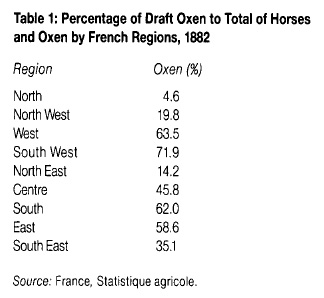 Display large image of Table 1
Display large image of Table 17 If the ox could do about two-thirds the work of a horse (the conclusion of a twentieth-century American professor of animal husbandry)8 then the two would have equal rates of return and the decision of which to use would have to be based on other considerations.
8 The situation is more complex, however, because other authorities give different figures for both costs and benefits. Young, for instance, argues that horses cost about twice as much as oxen, but he confuses costs and returns when he assumes that two oxen do the work of one horse.9 So oxen are really only one-quarter as expensive as horses. Here too, if we choose judiciously, we can find an author writing at the end of the sixteenth century, Olivier de Serres, whose figures for work done give equal returns for both animals: the horse, he says, "moves more earth in one day than the ox does in four."10
9 A Scottish farmer of the 1840s, to cite another example, discovered by experience that horses and oxen had about equal costs, the oxen being slightly higher. While plowing, "the amount and value of the work performed by each are equal."11 The same conclusion about the relative amounts of work performed by two animals was drawn by a former Massachusetts Commissioner of Agriculture reporting on his European travels in 1847.12
10 The weight of evidence would seem to indicate that in the fundamental agricultural task of plowing, the oxen's lower cost was offset by the horse's ability to perform more work. There was therefore no clear reason to prefer one animal over the other. This fact may help to explain the persistence of the two, side by side for hundreds of years, and is what we would expect if a single market existed for the two animals.
11 The farmer would have to base his choice on other factors relating to local conditions and how each animal would fit into the total farm economy. Though there were exceptions, two general conclusions may be proposed: first, that oxen are found in poorer areas that are less market-oriented while horses are found in prosperous, advanced regions; and second, that horses tend to displace oxen over time. The second point may be another way of saying that western agriculture moved steadily toward market involvement.
12 The centuries-long process by which horses replaced oxen can best be described for England. It began soon after the Conquest when horses accounted for approximately five to ten per cent of work animals.13 The percentage of horses rose to about 12 per cent by the end of the twelfth century.14 Between 1200 and 1500 the number of horses increased again to about 30 per cent of draft animals on demesnes and about 40-60 per cent on peasant farms.15 As Langdon explains, the greater use of horses by subsistence peasants was due to the horse's versatility which enabled them to accomplish many tasks with few animals: demesne farming, however, could be more specialized and use horses and oxen for different tasks.16
13 Between 1500 and 1700 the replacement of oxen by horses proceeded.17 The introduction of the lighter Rotherham plow in 1730 encouraged this trend, so that as early as the mid eighteenth century oxen had vanished from some areas.18 Elsewhere oxen continued to be favoured as draft animals. They were also favoured by "nearly all" late eighteenth-century agricultural writers for their supposed lower cost.19 A similar sentiment seems to have prevailed in eighteenth-century Canada whose inhabitants were chided for their excess fondness for expensive horses, which left them too few cattle.20
14 Whatever the reformers may have hoped, by the early nineteenth century the tide was running too strongly in favour of the horse and their encouragement of the use of oxen went for naught. Mentions of draft oxen in England in the 1830s to 1850s seem to imply that they are a survival or sign of backwardness.21 By the twentieth century oxen were portrayed as curiosities or museum pieces, much like Laxton, the surviving open field village.22 The ox was the symbol of backward farmers in remote places.
15 Oxen remained more widespread in France and the United States though here, too, they tended to be a sign of backwardness. The United States census of 1850 reported 1.7 million working oxen, 28 per cent of the total number of horses and oxen.23 In France there were 1.5 million oxen in 1882, 42 per cent of the country's total working horses and oxen.24 Neither of these figures tells the whole story, however, for there were also 550 000 asses and mules in the United States, and cows were used for plowing in various south-central regions of France.25 In keeping with their wider use than in England, oxen were regarded as more or less normal on French farms; among the photos illustrating a 1914 book on the value of land in France, for example, six show oxen pulling plows while only two show horses.26 This is in part an indication of the backwardness of French agriculture.27
 Display large image of Table 2
Display large image of Table 216 Within France, backward, subsistence farmers were more likely to use oxen. Novels like Guillaumin's La vie d'un simple and Bachelin's Le village, which depict picturesque, old fashioned farm life, have oxen or cows plowing.28 French statistics from 1882 tell a similar story; the highest concentrations of horses are in the northern departments, usually assumed to be the most advanced, while oxen are found in the backward south and west (Table 1, Fig. l).29The results are even more striking if the departments are divided according to Louis-Marie Goreux's classification of their distance from economic centres.30 There is a significant decrease in the percentage of draft oxen as one moves further from these centres (Table 2, Fig. 2).
17 United States statistics lead to the same conclusion. New England, the region with the poorest agriculture, had the highest proportion of oxen, while the rich Midwest had the lowest (Table 3, Figs. 2, 3, 4).
18 In addition to New England, in 1850 oxen were found on the frontier, for example in Michigan, Wisconsin, Minnesota and Oregon. As the frontier moved, twenty years later the highest concentrations of oxen outside New England were in the mountain states and the Dakota Territory. Proportions in Michigan, Oregon and Wisconsin had declined (Fig. 3). On the frontier, oxen were preferred because they were better able to break the prairie sod. Their lack of speed was perhaps not a problem since markets were not available at first. Moreover, during the difficult early years, pioneer farmers were not able to grow the extra feed grain needed by horses. By 1890 the end of the frontier eliminated this factor as a determinant for the location of oxen. Along with New England, the South now had the highest proportion of oxen, and in the case of Alabama, Florida, North and South Carolina it actually increased. Is this a sign of the relative impoverishment of the South after the Civil War?
19 There is evidence of similar patterns in Canada. In the Lower Richelieu region oxen were prominent early, but by the end of the eighteenth century "tended to be replaced by additional horses."31
20 These relationships raise several questions. Which comes first? Do horses make agriculture prosperous or are horses used where agriculture is already well off? Cross-sectional data cannot produce a clear answer. White's argument about the introduction of horses into medieval agriculture would have horses causing the advance. Langdon's account, on the other hand, suggests that horses were introduced where conditions were favorable for them. I would agree: horses replaced oxen when and where farmers were prosperous enough to afford them.
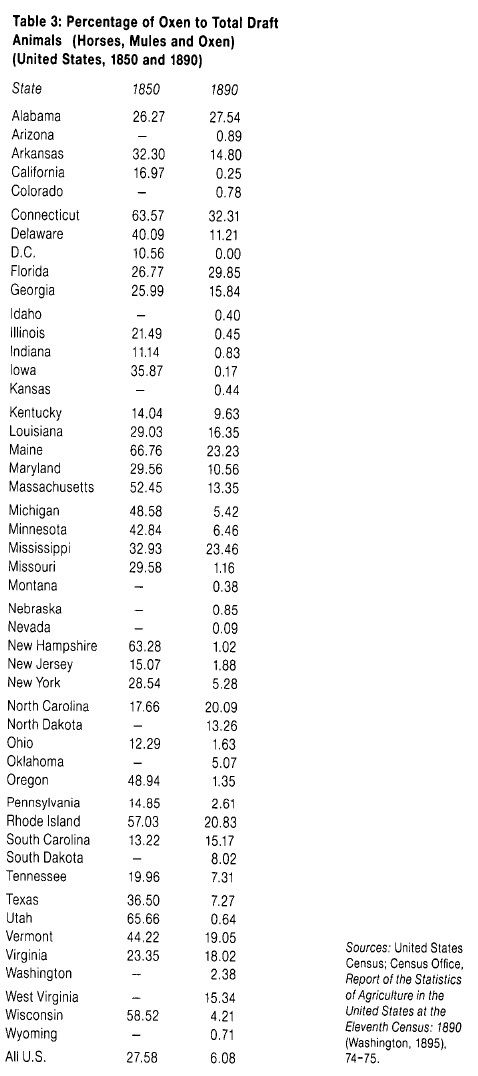 Display large image of Table 3
Display large image of Table 321 Why should these backward regions have had the greatest proportions of oxen? To answer this we first have to define backwardness. Most importantly, it signifies isolation from markets or, at least, the lack of a single marketable crop. The concept implies small farms with primitive technology producing little, mostly for on-farm consumption. Operators of such farms would prefer oxen because they fit in better with the farms' needs and structures. Most farmers would want to produce milk, for itself or for manufacture into butter or cheese. Cows therefore had to give birth annually. Half of these off-spring would provide replacement cows, but another use would have to be found for the males. They could either be slaughtered for veal or raised for work, thereby providing farmers with replacement oxen whose only cost was that of the grass and hay, usually farm-produced, they ate until they were ready for work. Raising oxen for labour would involve little cash outlay, which was an advantage for subsistence farmers, proverbially short of money.
22 The ability of oxen to work on a grass diet again meant less need either to purchase oats or to devote land to producing them. In France, oats were not grown in the areas where oxen dominated. Cause and effect might be disputed here, but it does seem that the climate of southern France was not suitable for this crop.
23 Part of the motivation for keeping oxen in France and the United States, as in Britain, was thus to reduce costs or outlays for subsistence farmers. These farmers did not need the horses' extra speed because their farms produced just enough for home consumption: additional speed would thus be wasted. The horse's versatility, which led to its use on medieval peasant farms, did not impress these farmers who found their oxen better-adapted to the tasks they had to perform. The ox's versatility also explains its dominance in the most recently settled states and territories of the United States, as well as its popularity among farmers in northern New England and eastern Canada where summer use on the farm could be combined with logging in the winter.32
24 In addition to a preference for oxen where low cost was a prime criteria, oxen also survived on both large, profitable farms and small ones when particular needs or circumstances encouraged their use. Soil conditions, for example, might make one animal superior to the other. Horses would do better on light and stony ground while oxen would have the edge in heavy clay soil.33 A farm with three tractors in the Parisian basin in the mid twentieth century was modern, even for its time. Nevertheless, it had ten horses and twelve oxen to plow its 90 hectares of wheat, 40 of oats, 10 of barley, 65 of sugarbeets, etc.34 Although the author doesn't say so, sugarbeet growing was probably a crucial factor in the use of oxen because cattle can be nourished on the byproducts of sugar production.35 At the start of the twentieth century, a study of Picardy in northern France explicitly made the point that sugarbeet cultivation led to the introduction of draft oxen in an area where they had not been before.36
25 As a further example of how modern farming could use oxen, Lecouteux, author of books on agricultural improvement and editor of a leading French agricultural journal in the mid nineteenth century, described model farms using oxen along with horses for plowing. To produce high yields, especially for sugarbeets, some land needs deep plowing, for which he recommends a plow drawn by six oxen, followed by another pulled by two horses.37 On these large farms of several hundred hectares oxen seem to have played the same specialized role that they did on the medieval demesnes described by Langdon. The same advantage was cited when oxen were recommended to American pioneers for their ability to break the heavy sod of the plains.38
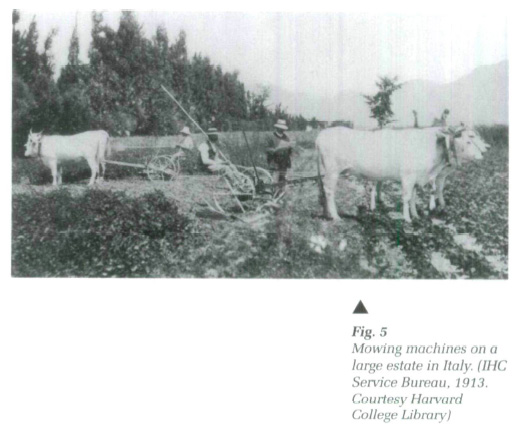 Display large image of Figure 5
Display large image of Figure 526 Oxen might also be integrated into progressive farming as part of livestock raising which steadily grew in importance with expanding urban demand and improved transport in the mid and late nineteenth century. Breeding beef cattle for regional or national markets was a complex process. After birth, calves would be raised for several years and finally fattened for the market. All three of these stages might be carried out by different farmers, or the first two were frequently separated from the last. Young oxen might be worked before fattening, a practice sometimes said to help them put on flesh or improve its quality.39 On certain large farms, oxen were bought and sold annually; elsewhere they were kept for several years. On small farms, oxen were worked until their strength began to give out, at which time they were fattened and sold or slaughtered. It was this situation that Walter of Henley contemplated when he made his often quoted comparison:
The possibility of converting draft oxen into meat had always been a major argument in their favour. For example, Arthur Young's cost figures of more than 2:1 in favour of oxen are based entirely on the possibility of selling each ox for fattening; otherwise, purely for plowing, horses are much cheaper.41 Cattle were also valued for their manure, the main fertilizer throughout the nineteenth century.
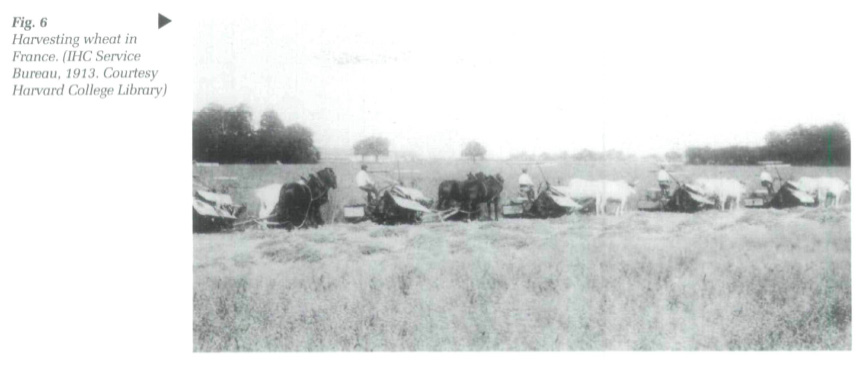 Display large image of Figure 6
Display large image of Figure 627 Along the same lines, a new type of stock-raising in the Limousin in the third quarter of the century produced calves for sale to Paris and to regions where they could be fattened. In this situation, older males were not kept and cows became the essential animals, used both for breeding and work.42 In Brittany where horses were raised, however, oxen did most of the work, while they did little in the dairying region of Normandy.43 A myriad of alternatives existed for integrating oxen and cows, as well as horses, into farming.
28 There were thus a variety of ways in which draft oxen might fit into the farm economy and therefore many reasons for keeping them. Modern, large-scale grain farming seems to have been the only form of agriculture that had no place for them. Their complex position as a joint product also means that it is difficult to compare the costs and benefits of oxen and and horses.
29 Through such adaptations on the part of different farmers, oxen remained a part of agriculture down to the middle of the nineteenth century, even in the most advanced western countries. From this time on they disappeared rapidly in England and the United States, less so in France. "Working oxen" declined in the United States from 28 per cent of the total of horses and oxen in 1850 to 27 per cent in 1860, 16 per cent in 1870, 9 per cent in 1880 and 7 per cent in 1890.44 The 1900 census stopped counting them. By the twentieth century, few oxen were left.
30 The demise of oxen was the product of several factors. New machines for haying and grain harvesting were made for horses. As Chivers writes,
There is some evidence, however, that where oxen were the favoured draft animal, machinery could be adapted, probably by gearing, to meet their requirements (Fig. 5).
31 Improvements in transportation and the consequent opening of all farmers to national and international markets also played a role. In England the breeding of cart horses for work in the cities made it worthwhile to use the brood mares for agricultural work.46 Feed for horses could now be bought cheaply and cattle became more valuable as steers for fattening than as working oxen which were no longer desirable as beef at the end of their working lives.
32 These processes finally brought to a conclusion the centuries-long process by which horses replaced oxen behind the plow. Yet the triumph of the horse in the industrial era, both on and off the farm, was to last only a few decades before it, in turn, would be replaced.
Earlier versions of this article were presented to the annual conference of the Social Science History Association, October 1987; Harvard Economic History Workshop, March 1988; and the Tenth International Economic History Congress, Leuven, Belgium, August 1990. The author would like to thank Kris Inwood and an anonymous referee for their encouragement and suggestions.
